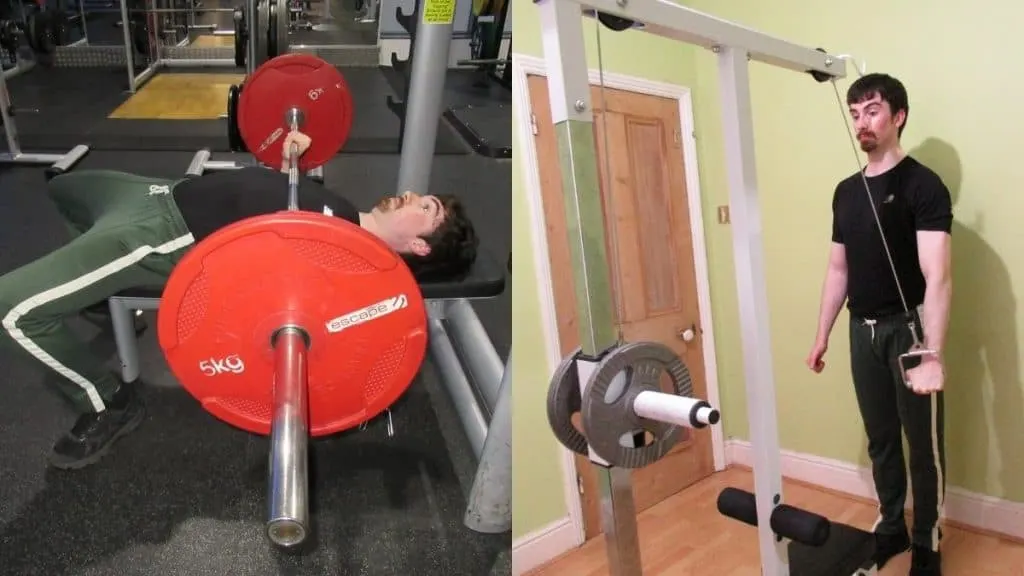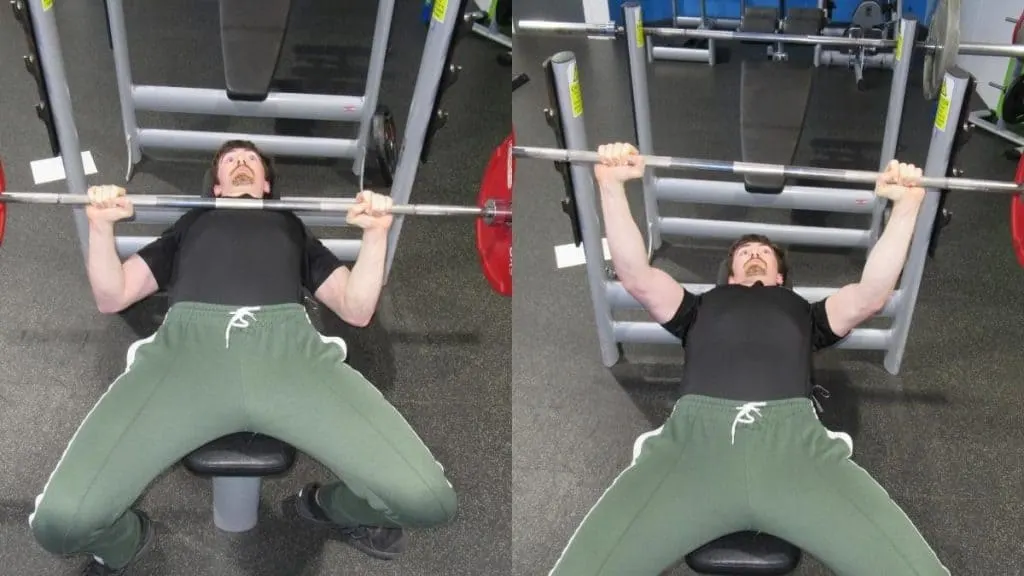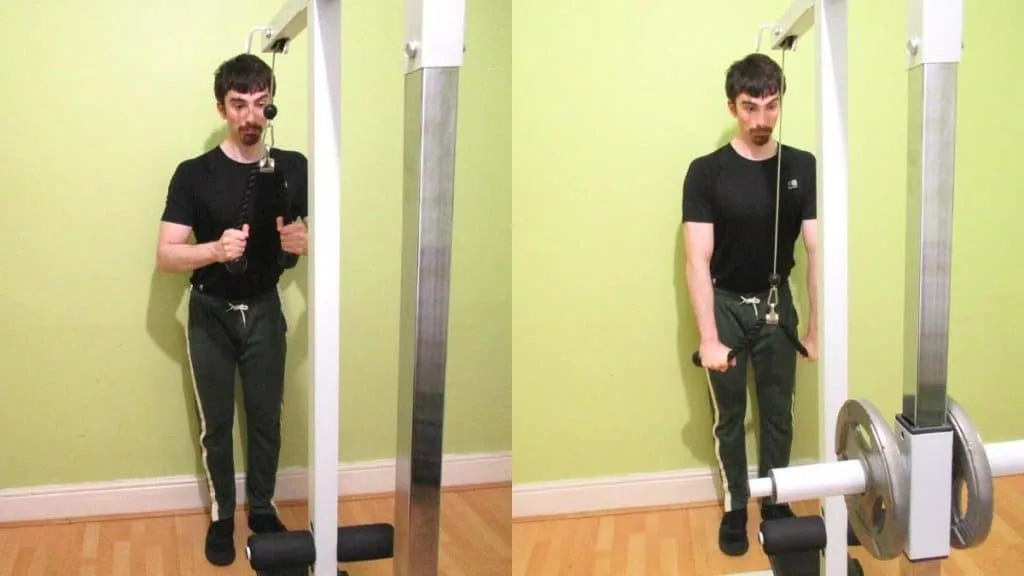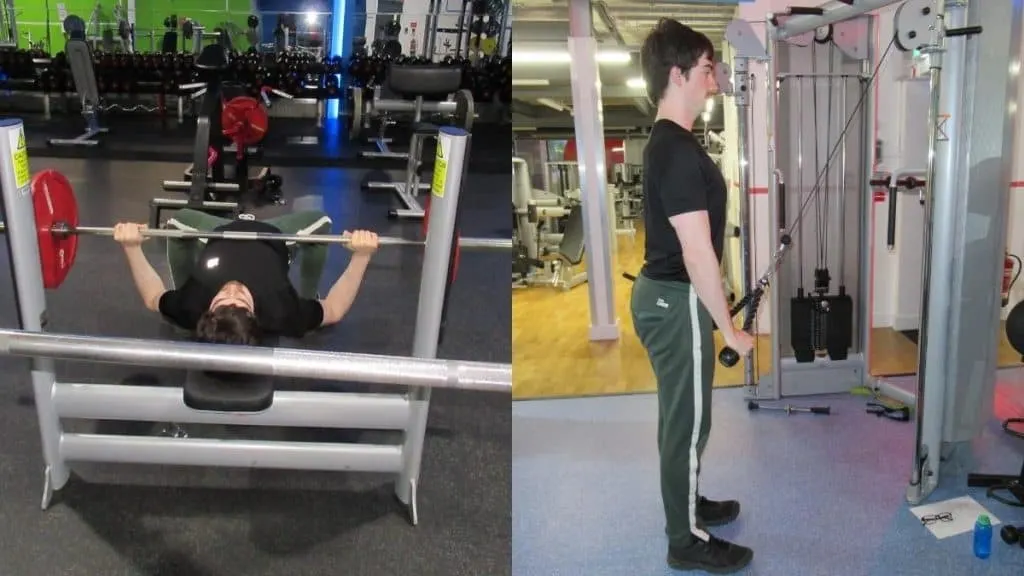If you’re looking for a simple yet effective chest and tricep workout for beginners that builds muscle mass and strength, then this is the routine for you.
You’ll learn precisely why I include each exercise in the routine and find out how it benefits your body.
I’ll also specify the reps and rest periods so that you can enjoy this beginner chest and tricep workout without any confusion.
Related Workouts:
- Chest and tricep workout with dumbbells
- Chest and tricep workout at home
- Chest and tri workout for women
- Chest and triceps superset workout
- Chest and tricep workout for cutting
- Chest and tricep workout without equipment
A full chest and tricep workout for beginners to build muscle

For best results, follow this beginner chest and tri workout in order. We’re starting with the hardest and heaviest exercises, so you’ll naturally want to do them when you’re at your freshest, which will definitely be at the start of your session.
The reps will gradually increase throughout the workout so that you can stimulate all of the different muscle fibers in your chest and triceps.
As for rep speed, you generally want to lower the weights quite slowly—especially during compound exercises—to prevent injury and give your muscles plenty of time under tension. [1]
Rest 2-4 minutes between sets of compound movements (bench presses) and 1 minute between sets of isolation exercises (skull crushers and pushdowns).
Exercise 1: Flat barbell bench press — 3-5 sets of 6-8 reps

The flat barbell bench press is a classic muscle-building exercise that makes a great addition to any workout. While many bodybuilders these days actually favor machines for training their chests due to the ease of setup, heavy barbell lifts are invaluable for beginners for a few reasons.
First off, gaining strength on compound barbell lifts is a reliable way to track your progress and thus validate your workout routine.
On the other hand, if you hop between machines, all of which are different, then you might end up just lifting light weights because you’ll probably start light whenever you change to a new machine.
As for the form, you want to lower the bar all the way down to your chest while keeping your elbows tucked in at a 45-degree angle. This will help to keep your shoulders safe while enabling you to generate plenty of pressing power with your chest and triceps.
- Load some weight onto a barbell and then lie back on the bench.
- Grab the bar slightly outside shoulder-width and then unrack it. Do not use a thumbless grip on the bar.
- Pin your shoulder blades back and stick your chest out. Tuck your elbows in at a 45-degree angle.
- Inhale and tighten your core, then lower the bar all the way down to your lower chest.
- Forcefully extend your elbows and aggressively drive your hands into the bar to push it off your chest. Exhale and blow the air out of your stomach as you do this.
- Repeat for 3-5 sets of 6-8 reps.
Exercise 2: Incline dumbbell bench press — 3-5 sets of 8-12 reps

Many novice lifters, especially those following traditional powerlifting programs, completely neglect their upper chest, which often results in pecs that lack balance between the two heads.
It’s not like the flat bench doesn’t work your upper chest; it’s just that incline presses emphasize the clavicular head of the pecs even more.
While you can definitely use a barbell for incline presses if you prefer, I recommend dumbbells because they provide your pecs with a deeper stretch and a stronger contraction. [2]
When paired with the heavy overloading provided by the barbell, dumbbells make a great addition to any beginner chest and tricep workout.
- Set the backrest of an incline bench to 30 degrees.
- Grab a pair of dumbbells and sit on the bench with the weights on your knees.
- Lie back and drive the weights up with your legs.
- Pin your shoulder blades back, tighten your abs, and stick your chest out.
- Tuck your elbows in at a 45-degree angle and then lower the weights down to either side of your chest.
- Keep going until you feel a deep stretch in your pecs. This will likely be just below where your elbows form a 90-degree angle.
- Reverse the motion by pushing the weights back up and across your body. Keep going until your elbows reach full extension.
- Repeat for 3-5 sets of 8-12 reps
Exercise 3: Dumbbell skull crusher — 3-5 sets of 10-15 reps

Even though it sounds like a potentially dangerous exercise, the deceptively-named dumbbell skull crusher makes an excellent addition to any chest and triceps workout for beginners.
The simple reason for this is that, in addition to overhead extensions, skull crushers are practically the only tricep exercise that trains the long head of the triceps optimally,
Unlike the other two heads of the triceps—the lateral and medial head—the long head crosses the shoulder joint and requires your arms to be behind your head when you perform a tricep extension for it to get a proper stretch.
Therefore, you actually want to lower the dumbbells behind your head rather than directly to your face or forehead. In practice, this means allowing some backward shoulder movement as you bend your elbows to lower the weights. You should feel a really strong stretch in the backs of your arms as you do this.
- Grab a pair of relatively light weights and lie back on a bench.
- Press the weights up with a neutral grip.
- Bend your elbows—while moving your shoulders back slightly—to lower the weights behind your head.
- Descend until you feel a deep stretch in the backs of your arms (in the long head of your triceps).
- Reverse the motion by extending your elbows forcefully until they’re fully locked out.
- Squeeze your triceps and repeat for 3-5 sets of 10-15 reps.
Exercise 4: Triceps pushdown — 3-5 sets of 15-20 reps

Tricep pushdowns are a popular exercise for every level of weight lifter because they’re easy to perform and yet highly conducive for building slabs of triceps mass.
You might feel confused over which attachment to use. But for me, the choice is easy. Go for the rope attachment because it enables you to get the best peak contraction in your triceps.
Some people may say to use the bar attachment seeing as it enables you to lift more weight. But you need to understand that more weight doesn’t always equal more tension on your triceps.
Additionally, by following this workout, you’ve already trained your triceps with heavy weight; now it’s time to pump them up with high-rep pushdowns, and the rope attachment is best for doing just that.
- Connect a rope attachment to the top of a cable machine.
- Grab the rope firmly, and then take a step back from the cable station.
- Move your shoulders and upper arms back so that they’re in line with your torso.
- Flex your triceps to push the rope down toward the ground. Keep going until your elbows are locked out.
- Release the contraction under control. Keep going until your forearms press right up against your biceps, then perform your next rep.
- Do 3-5 sets of 15-20 reps in total.
See Also: Beginner triceps workout
Conclusion: What makes a good beginner chest and tricep workout?

A good beginner chest and tricep workout should start with compound movements and end with isolation exercises. This setup enables you to target a wide range of muscle fibers by working your chest and tris from different angles.
Additionally, as a novice lifter, I highly recommend including both barbells and dumbbells in your routine so that you can become familiar with the two most important pieces of strength training equipment. This is taken care of with the first two exercises in the workout.
Any muscle growth-focused chest and tricep workout for beginners should also include either a lying tricep extension or an overhead extension so that you can train the long head of the triceps optimally.
You can, of course, substitute the exercises that you saw above for close variations that you personally prefer. For example, you can do weighted push-ups instead of bench presses, and you can swap dumbbell exercises for barbell exercises and vice versa.
References
- Pollack, B. (2018, July 19). How to Heal Any Injury Overnight: Safely and Effectively Training the Injured Area. Elite FTS. https://www.elitefts.com/education/how-to-heal-any-injury-overnight-safely-and-effectively-training-the-injured-area/
- Williams, L. (2020, March 11). Develop Your Pecs With the Incline Dumbbell Press. Verywell Fit. https://www.verywellfit.com/how-to-do-incline-dumbbell-press-4588212

